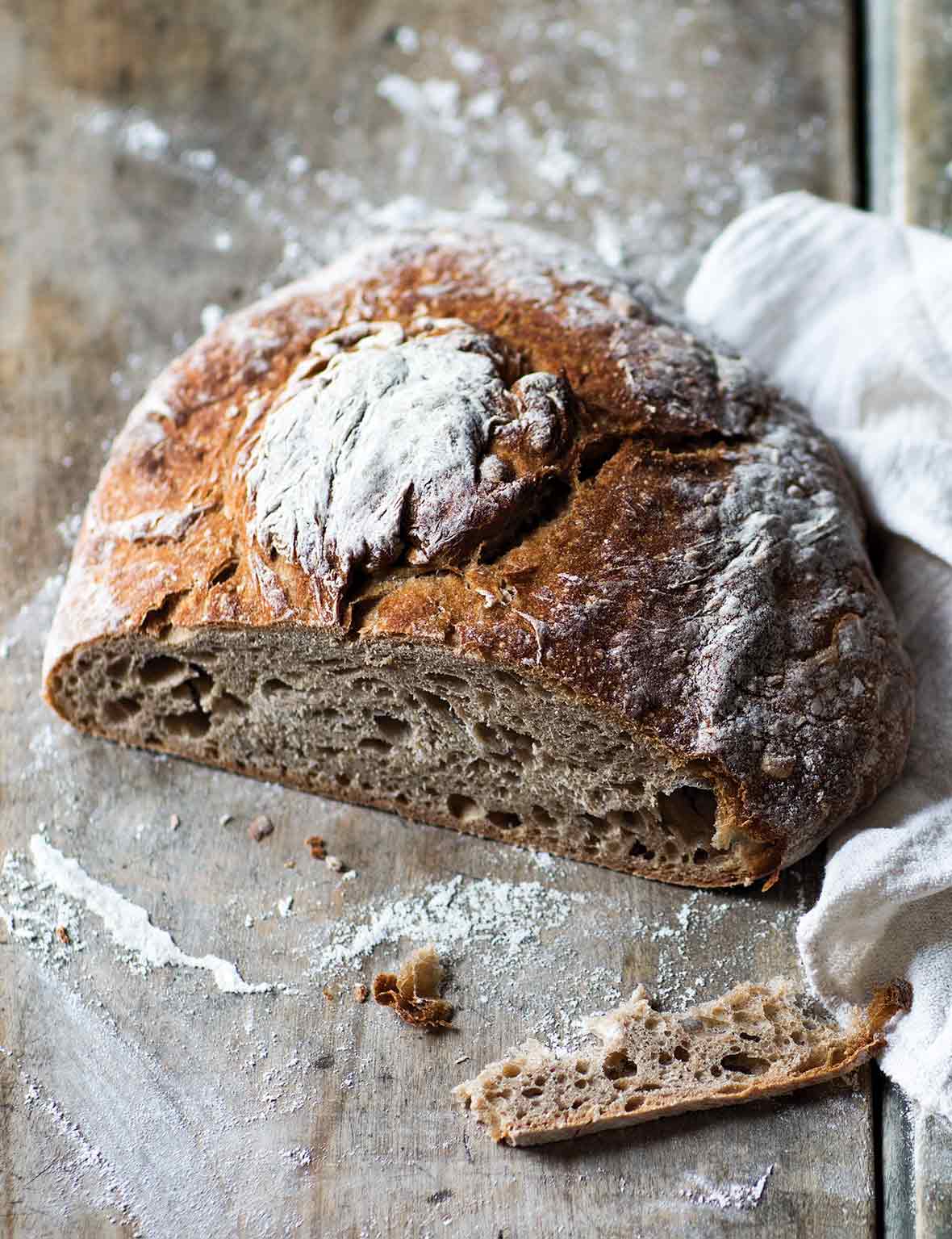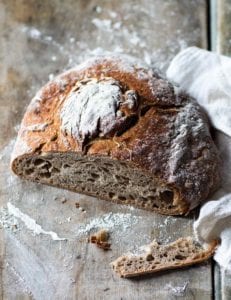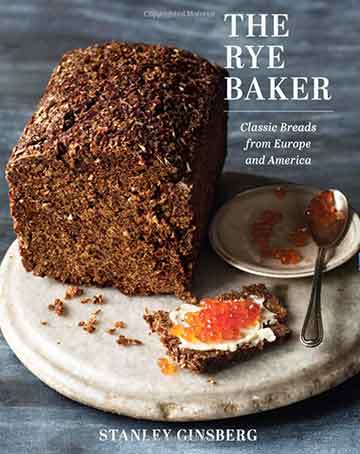
☞ Learn More, Read: How to Dry Sourdough Starter

Sourdough Rye Bread
Ingredients
For the rye bread sponge
- 6 ounces medium rye flour
- 6 ounces water
- 0.6 ounces rye sourdough starter
For the rye bread dough
- 10 ounces water, at room temperature
- 10.6 ounces bread flour
- 1 recipe rye bread sponge (see above)
- 2.3 ounces medium rye flour
- 1 1/2 teaspoons salt
- 1/3 teaspoon instant yeast
- Flour, for the work surface
Instructions
Make the rye bread sponge
- In the bowl of a stand mixer, mix the sponge ingredients by hand until incorporated. Cover and let ferment at room temperature (68 to 72°F or 20 to 22°C) overnight or for 10 to 12 hours. The sponge will be very bubbly, have a clean sour smell, and will have doubled in volume.
Make the rye bread dough
- Add the water and 1.8 ounces (50 grams) bread flour to the sponge and mix by hand until it forms a slurry, 1 to 1 1/2 minutes. Add 8.8 ounces (250 grams) bread flour and the rye flour and use the paddle to mix at low speed until the dough is evenly hydrated, 2 to 4 minutes. Cover the dough and let it rest at room temperature for 15 to 20 minutes.
- Add the salt and yeast to the bowl with the dough and mix with the dough hook of your stand mixer on low speed until the gluten is very well developed, 30 to 35 minutes. The dough should be sticky and very stretchy. Cover and let ferment at room temperature until doubled in volume, 2 to 2 1/2 hours.
- Preheat the oven to 430°F (220°C) with an oven rack adjusted to the middle position and a second rack in the lower position with a steam pan on it. [Editor’s Note: A steam pan is simply a pan filled with some water. You’ll want to use a pan with relatively high sides and only fill it partway with water as you’ll need to remove the pan from the oven when the water is very hot and you don’t want it sloshing all over you or your oven.] If using a baking stone, place it on the middle rack.
- Turn the dough onto a generously floured work surface and gently form it into a ball by folding it toward you, rotating 90 degrees, and repeating until the bottom surface is smooth. Flip the dough. If a traditional Galician rye bread shape is desired, pinch a golf ball-size piece of dough from the center of the loaf and carefully stretch it upward without separating it from the loaf, then form a depression in the dough and nestle the ball of dough inside the depression. Place the dough on a parchment-lined baking sheet or, if using a baking stone, on a well-floured peel. Cover and proof at room temperature for 10 minutes.
Bake the rye bread
- Bake the rye bread for 15 minutes.
- Remove the steam pan from the oven, quickly shut the oven door, and lower the temperature to 390°F (200°C). Continue to bake the bread until the crust is golden brown, the loaf thumps when tapped with a finger, and the internal temperature is at least 198°F (92°C), 15 to 25 minutes more.
- Transfer the loaf to a wire rack and let it cool completely before slicing.

Nutrition
Nutrition information is automatically calculated, so should only be used as an approximation.
Recipe Testers’ Reviews
Loved, loved, loved this sourdough rye bread recipe! It was perfect! This is an excellent recipe for those who love their classic sourdough rye bread. It turned out absolutely beautiful with a nice golden brown crust and a complex sourdough flavor. I am very, very pleased with this loaf and will definitely be making it again!
This sourdough rye bread is a higher hydration dough, which was supposed to give it a nice open crumb. I didn’t achieve that, but it still had a nice flavor. It was a very mild sourdough rye bread and could go with many different foods.










I’m stuck at the sponge part. It’s been sitting for 15 hours now and hasn’t bubbled or increased in volume. The starter was bubbly and smelled great. My house may be too cold? It’s set at 71F but was down to 66 overnight. Should I give up and try again or keep waiting?
Ruth, just to confirm, your starter is fully active and is doubling (or close to) after you feed it? If your starter is good and active, then yes, I think it may have been too cold for it to work. You may want to try again, and if your home is cold at night, try putting it in the oven with the light on.
Thank you. I let the sponge sit a few more hours and when I stirred it was bubbly though not risen much. I went ahead and made the bread using the light on in oven for the raising part. The bread turned out pretty dense but still tastes great. Will use the oven overnight for the sponge next time.
Thanks, Ruth! I’m glad you enjoyed it. Do let us know how that works out for you.
Ruth, I’m going to tell you a little secret that I’ve never told any of our readers. (And I risk ostracization from sourdough circles for this!) When I start a new starter recipe, especially something as heavy as rye, I added a tiny, tiny pinch of yeast to it to give it a headstart. I don’t feel too bad about it, as Apollonia Poilâne of the famous Poilâne bakery in Paris suggests the same thing when taking her course on Masterclass.
I have no mixer, so all bread that I make is done by hand, so am interested to know if it would work. I make sourdough bread all the time, using different flours grains, and seeds, but have a fancy to make pan de gallago, for something completely different, although with all those holes, I can see the peanut butter or marmalade dripping. HaHa! Also, I have only fresh yeast, no powdered varieties, and wonder why you would need to add yeast anyway if I have a healthy starter?
Jenny, if you want to make this by hand, I’d be prepared for quite the arm workout. The kneading process in the mixer is very lengthy, but if you’re up for the challenge, there’s no reason why you can’t do it by hand. The addition of the yeast allows the bread to rise more quickly. If you want to substitute fresh yeast for the instant, you’ll need about twice as much, and will need to dissolve it in the water and add it in step 2. If you try it, do let us know how it turns out!
This is the first sour dough bread that I have ever made and the first rye bread that I have ever made. I followed this recipe twice last week with so-so results. Today’s loaf, which is my third attempt, worked well for me. To make this loaf successful, I added 2 oz of bread flour and 2 oz of rye flour to make the dough less runny. I also increased the amount of yeast to 1 tsp. Additionally, I let the starter sit for almost 48 hours after its last feeding, and the sour dough taste is stronger than before.
Thanks so much for sharing your experience with us, Leslie. Every bread recipe (and bread baker!) is a little different, so it always takes a little time to figure out how to make it work best for you. We’re delighted you kept at it until you were happy with your loaf.